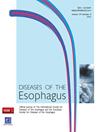552.机器人食管切除术与视频辅助胸腔镜食管切除术治疗食管鳞状细胞癌的比较:revate随机临床试验的结果
IF 2.3
3区 医学
Q3 GASTROENTEROLOGY & HEPATOLOGY
引用次数: 0
摘要
背景 食管鳞状细胞癌(ESCC)的治疗包括沿喉返神经(RLN)解剖淋巴结,这在肿瘤学上非常重要,但对技术要求很高。喉返神经损伤导致的声带麻痹会带来严重的并发症。这项随机临床试验(RCT)比较了机器人食管切除术(RE)和视频辅助胸腔镜食管切除术(VATE)进行RLN淋巴结清扫(LND)的疗效和安全性 方法 我们于2018年11月至2022年3月进行了一项多中心RCT(NCT03713749),招募了需要进行麦氏食管切除术的ESCC患者。主要终点是确定左侧RLN LND的成功率。成功率的定义是经病理证实的淋巴结切除,且不造成永久性神经麻痹(持续时间> 6个月)。次要终点包括围手术期和肿瘤学结果。结果 按方案分析包括203名患者的数据(RE组:n=103;VATE组:n=100)。88.3%的 RE 组和 69% 的 VATE 组达到了主要终点(p<0.001)。此外,与 VATE 组相比,RE 组纵隔淋巴结摘除率更高(16 [12-22] 对 14 [10-20],p=0.04),胸腔手术时间更短(110 [89-137] 分钟对 124[103.5-154] 分钟,p=0.004),引流清除时间更早(4 [3-7] 天对 6 [4-9] 天,p=0.007)。两组的并发症发生率相当,均无院内死亡记录。结论 这项多中心试验证明了 RE 在提高 ESCC RLN LND 的可行性和安全性方面的有效性。此外,RE 还改善了纵隔淋巴结切除术,缩短了手术时间,并能更早地清除引流物。本文章由计算机程序翻译,如有差异,请以英文原文为准。
552. COMPARING ROBOTIC ESOPHAGECTOMY TO VIDEO-ASSISTED THORACOSCOPIC ESOPHAGECTOMY FOR ESOPHAGEAL SQUAMOUS CELL CARCINOMA: RESULTS FROM THE REVATE RANDOMIZED CLINICAL TRIAL
Background The treatment of esophageal squamous cell carcinoma (ESCC) includes dissecting lymph nodes along the recurrent laryngeal nerve (RLN), which is oncologically important but is technical demanding. Vocal cord palsy as a result from RLN injury, carries significant morbidities. This randomized clinical trial (RCT) compared the efficacy and safety of robotic esophagectomy (RE) and video-assisted thoracoscopic esophagectomy (VATE) for performing RLN lymph node dissection (LND) Methods We conducted a multicenter RCT(NCT03713749) from November 2018 to March 2022, enrolling patients with ESCC who required McKeown esophagectomy. The primary endpoint was to determine the success rate of left RLN LND. Success was defined as the removal of lymph nodes confirmed by pathology, without causing permanent nerve palsy (duration > 6 months). Secondary endpoints encompassed perioperative and oncological outcomes. Results The per-protocol analysis included data from 203 patients (RE group: n=103; VATE group: n=100). The primary endpoint was achieved in 88.3% of the RE group and 69% of the VATE group (p<0.001). Additionally, the RE group had a higher mediastinal lymph node harvest (16 [12−22] versus 14 [10−20], p=0.04), shorter thoracic operating time (110 [89−137] min versus 124[103.5−154] min, p=0.004), and earlier drainage removal (4 [3−7] days versus 6 [4−9] days, p=0.007) compared to the VATE group. The two study arms exhibited comparable complication rates with no recorded in-hospital deaths in either group. Conclusion This multicenter trial demonstrates the effectiveness of RE in enhancing the feasibility and safety of RLN LND in ESCC. Additionally, RE leads to an improved mediastinal lymphadenectomy, shorter operating times, and earlier removal of drainage.
求助全文
通过发布文献求助,成功后即可免费获取论文全文。
去求助
来源期刊

Diseases of the Esophagus
医学-胃肠肝病学
CiteScore
5.30
自引率
7.70%
发文量
568
审稿时长
6 months
期刊介绍:
Diseases of the Esophagus covers all aspects of the esophagus - etiology, investigation and diagnosis, and both medical and surgical treatment.
 求助内容:
求助内容: 应助结果提醒方式:
应助结果提醒方式:


